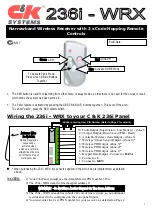
V A L A V I O N I C S L T D
N A V 2 0 0 0 N A V I G A T I O N S Y S T E M
I N S T A L L A T I O N A N D O P E R A T O R ’ S M A N U A L
Pre-Release Issue
Page 22 of 29
Sept. 2013
8.6 Message Definitions
Input Messages
REQUEST DATA OUTPUT
This input is used to request an output message to be sent by the NAV 200.
Message format:
“V” ...............................Message class. This is a VHF NAV message.
“24” ..............................Message identifier.
ii ....................................Output identifier of requested message, two ASCII characters.
dd...................................Message data, two encoded hex
2
characters (30h-3Fh), used for specific
output request. Set to “00” if not needed. These characters are used for
such items as selecting a specific EEPROM address to output.
A....................................Request type: (ASCII) “0”= output repeatedly at low speed (1 Hz); “H” =
output repeatedly at high speed (10 Hz).
ii
Output
Dd
Data Description
a
“20”
Reset Status
“00”
“0”
“21”
CDI, GSI, and Flags
“00”
“0”, “L”, “H”
“22”
Decoded OBS Setting
“00”
“0”, “L”, “H”
“23”
Radial from Active VOR
“00”
“0”, “L”
“28”
Receiver Status
“00”
“0”
“30”
NAV Microntroller Software Version
“00”
“0”
“32”
ADC Data Output
cc
ADC channel: “00”
to “08”
“0”
“35”
Comm Transceiver Status
“00”
“0”
“36”
Comm Software Version
“00”
“0”
Table 5 -
Data Output Requests
Example messages:
$PMRRV242100L<chksm><CR><LF>
Request periodic output of CDI, GSI, and related flags at low (1Hz) rate.
$PMRRV2432050<chksm><CR><LF>
Request a single output of ADC data from channel 5.
SET ACTIVE VOR/LOC FREQUENCY AND RECEIVER FUNCTION
This message is used to set the standby VOR or Localizer frequency as well as the receiver
operating function. The NAV 2000 can detect if the supplied frequency corresponds to a VOR or a
Localizer channel, so this command will work for both types of NAV aids.
2
Encoded Hex: each character consists of 4 bits of data placed in the low order 30h. For example,
the 8-bit value of 5Fh would be encoded as two characters with values of 35h and 3Fh, which map to the
ASCII characters “5” and “?” respectively.








































